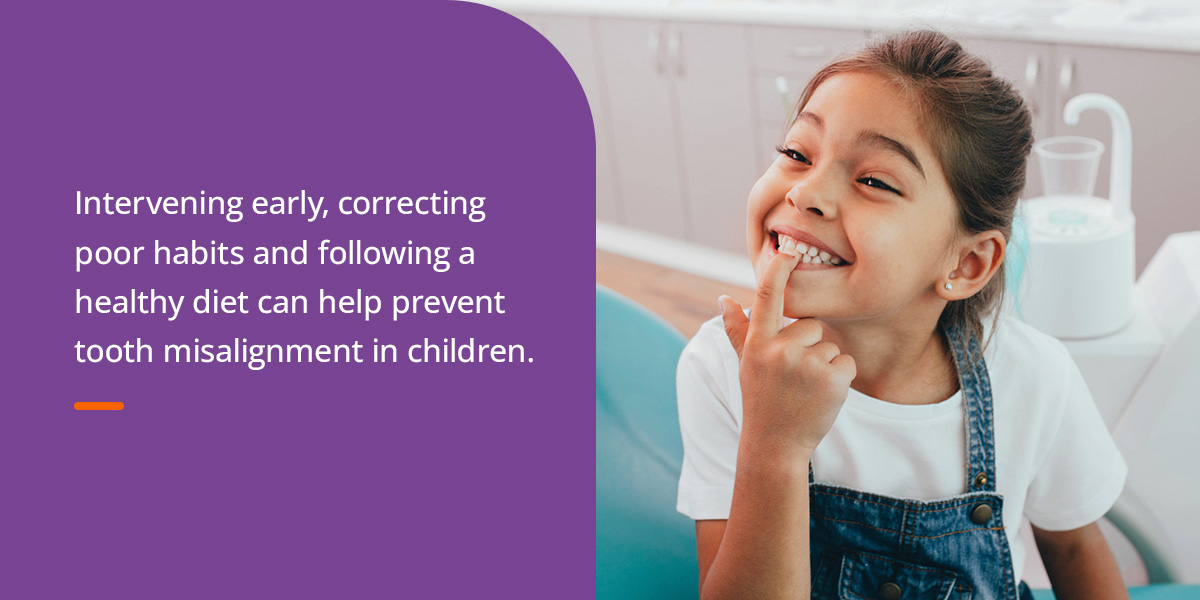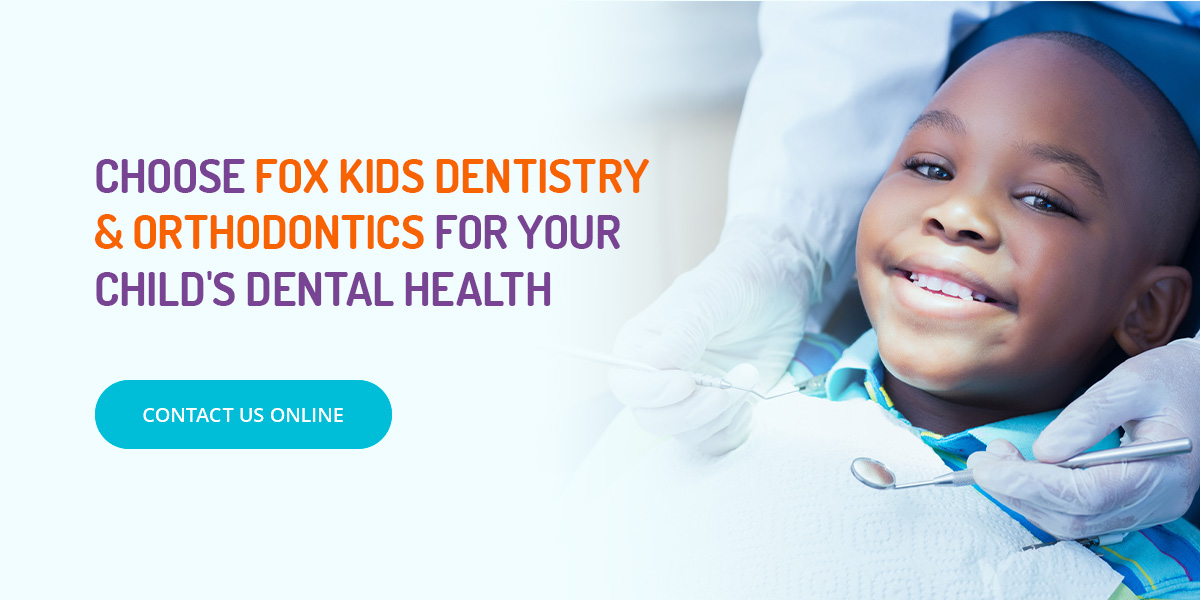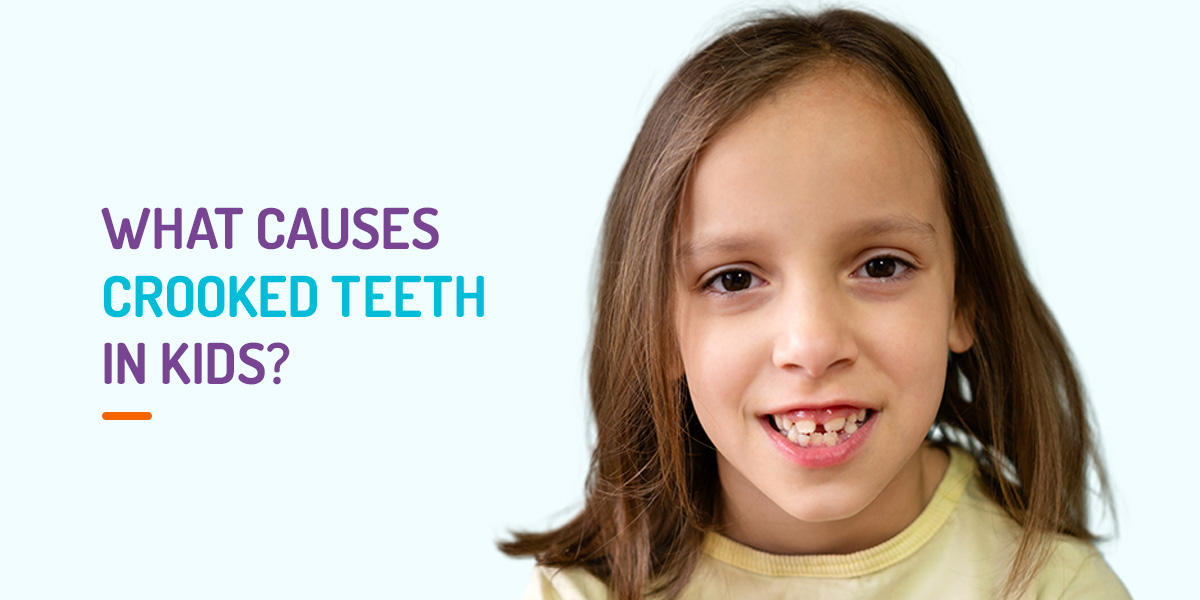Crooked teeth are far more common than you might think. In fact, about nine in 10 people have slightly misaligned teeth. While this issue is usually a cosmetic complaint, skewed teeth can sometimes become a health concern. When teeth misalignment interferes with brushing and flossing, the risk of tooth decay, gum disease and tooth loss increases.
Misaligned teeth can also impact speech and make chewing foods a challenge. But even without these issues, crooked teeth can affect confidence. Younger children might bear toothy grins without a care, but as they grow older, they may shy away from genuinely smiling as they try to hide their teeth. Fortunately, it is possible to correct and prevent a misaligned smile.
Why do kids develop skewed teeth? Here, we’ll explore the common causes of crooked teeth in children, as well as dental correction and prevention techniques.
Major Factors Leading to Crooked Teeth
Baby teeth can come in crooked, but even straight baby teeth can fall out and be replaced by skewed ones. Even straight permanent teeth can skew later on.
While genetics play a significant role, several other factors can influence tooth development and position. Mouth breathing, thumb sucking, tongue thrusting, trauma and early baby tooth loss can play a role. Diet and nutrition also impact tooth development and are key in maintaining oral health.
These factors can influence tooth development and alignment:
1. Genetics
A skewed smile can run in the family, as genetics play a role in tooth, jaw and tongue development. Like hair and eye color, these facial features develop through genetics by traveling through bloodlines. So, if you’re wondering why your kids’ teeth are crooked, it might be due to genetics.
Crooked teeth can emerge from a small jaw that doesn’t leave enough room for each tooth to fit, causing overcrowding. Tooth size is another genetic factor that can lead to misalignment. If one parent has large teeth and the other has a small jaw, their child might inherit the traits. An overbite, underbite, crossbite or open bite can cause misaligned teeth. These issues stem from jaw misalignment, which usually results from genetics.
Beyond hereditary small jaws and large teeth, genetic factors are also linked to excess teeth. Extra teeth, a condition known as hyperdontia, can result from genetic disorders like Gardner syndrome, cleidocranial dysplasia and cleft lip.
2. Poor Habits Impacting Dental Structure
Thumb sucking is a self-soothing action adopted by many infants and toddlers. The autonomous thumb-in-mouth motion usually starts within a few weeks of birth for many little ones, and they may be introduced to pacifiers around the same time. Pacifiers may help prevent thumb sucking and aid self-soothing, although both thumb sucking and pacifiers can cause crooked teeth.
Thumb sucking and pacifiers can affect teeth alignment by weakening the jaw, leading to jaw misalignment. The habit can also cause the upper front teeth to tilt forward and even prompt the development of a lisp. The sucking habit can also cause buck teeth, a crossbite and an open bite and alter the shape of the roof of the mouth.
When thumb sucking and pacifier use continue after baby teeth emerge or when the permanent ones arrive, dental issues can arise, too.
3. Tongue Thrusting
Tongue thrusting is the motion of pushing the tongue forward against the back of the teeth. It is caused by orofacial myofunctional disorder (OMD). The constant extra pressure on the teeth can eventually cause misalignment.
When tongue thrusting persists into adolescence, the impacts on dental health can be severe, as the additional pressure will eventually alter jaw bones and even facial features.
4. Early Baby Teeth Loss
Parents may overlook the significance of early loss of baby teeth. They’ll fall out anyway, so what’s the big deal? Baby teeth are essential for facial development. These primary teeth help little ones speak and chew. They also hold space for permanent teeth.
When a baby tooth falls out too soon, the permanent tooth below won’t come in right after, leaving a gap open for too long. The other teeth will begin to shift into the gap, and the permanent tooth may not erupt correctly, causing misalignment.
5. Mouth Breathing
While there’s no harm in breathing through your mouth while recovering from clogged sinuses or the flu, constant mouth breathing can eventually alter facial structure and teeth alignment. A narrow face, misaligned teeth and a receded jaw are commonly associated with excessive, prolonged mouth breathing. These issues can also potentially lead to temporomandibular joint dysfunction (TMD).
6. Diet
A healthy, balanced diet is packed with nutrients that aid healthy teeth and bone development. Calcium, vitamins D, C, A and protein are just some of the essential nutrients influencing bone growth and health.
When poor diet and malnutrition come into play, little ones may develop crooked teeth, poor jaw structure and even fragile bones. A lack of certain nutrients, like calcium and vitamin D, can delay tooth eruption and impact bone mineralization.
7. Poor Oral Hygiene
Poor oral hygiene can cause more than yellowing teeth — it can cause gum disease, which can develop into periodontitis, which can cause tooth loss, shifting and misalignment. Regularly brushing with fluoride toothpaste and flossing can keep these oral health concerns at bay.
8. Trauma
Injury and trauma, such as a blow to the face, can cause loose or missing teeth. If the issue is not corrected, teeth may heal crooked as they shift to fill the gap of a missing or loose tooth.

Preventive Measures and Early Intervention
Whether misalignment is genetic or caused by poor habits like thumb sucking, there are ways to prevent misalignment. Intervening early, correcting poor habits and following a healthy diet can help prevent tooth misalignment in children.
1. Early Orthodontic Evaluation
Some parents might think orthodontist checkups are only necessary for teens as permanent teeth have settled in. However, scheduling a checkup from age 7 has several benefits.
By this age, the first molars should erupt to establish a child’s bite, allowing an orthodontist to identify the early signs of misalignment and intervene before crooked teeth set in. Orthodontists can address potential dental issues and tailor a treatment plan to encourage alignment and healthy jaw development.
2. Addressing Poor Oral Habits
Thumb sucking, extended pacifier use and mouth breathing are all poor oral habits that parents can address early. If your little one is struggling to wean from their pacifier or thumb sucking, try to encourage self-awareness to break the habit. Positive reinforcement and fidget toys may also help.
Regarding mouth breathing, it’s worth visiting your general practitioner to manage potential allergies or sinus issues that may be disrupting breathing. Breathing training and orthodontic treatment can help when allergies and sinus troubles are not the cause.
3. A Healthy Diet
A balanced diet loaded with proper nutrients can aid healthy bone development. Likewise, following a healthy diet and avoiding sugary foods and beverages can maintain oral health. Start encouraging healthy eating habits from a young age to prevent cavities, gum disease and other oral health issues that can impact teeth and gums.
Choose Fox Kids Dentistry & Orthodontics for Your Child’s Dental Health
Fox Kids Dentistry & Orthodontics specializes in pediatric dentistry and orthodontics. We aim to make dental checkups a comfortable and pleasant experience for kids and their parents. We use the latest dental technologies to diagnose and treat kids’ crooked teeth.
Whether your little ones’ teeth seem skewed or your child’s permanent teeth are coming in crooked, contact us online or get in touch directly at 503-223-5039 to schedule an appointment.


